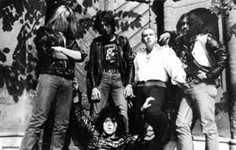Extra Enforcement Planned to Bring Down Traffic Deaths
Cars kill people
By Benton Graham, Fri., Aug. 19, 2022
In response to Austin's high rate of traffic deaths and injuries, the Austin Transportation Department and Austin Police Department plan to collaborate to boost traffic enforcement on high-speed roads, according to a July 27 memo by ATD's interim Director Richard Mendoza and APD Chief Joseph Chacon. "At this rate, and without any significant intervention, it is likely that 50 more people will die on Austin's streets and another 250 people will be seriously injured in the last six months of the year," the memo read.
The memo followed a City Council resolution directing staff to look into how the city could increase traffic enforcement, with a narrow focus on reducing traffic deaths, which currently sit below last year's record-setting pace, though serious injuries are higher than this time last year. It noted that most fatal crashes take place on the region's busiest roads, labeled in the Austin Strategic Mobility Plan as Level 4 (FM 2222, Parmer Lane, etc.) and Level 5 (I-35, MoPac, SH 130, etc.). With APD's resources limited, the memo suggests a potential partnership with Travis County constables.
Many in the community have misgivings about an approach that, in order to work, means more officers making more traffic stops that could turn into arrests or violent encounters. City Council Member Natasha Harper-Madison, who supported the resolution, said her family has experienced racial profiling and, at a meeting in June, asked her colleagues to consider these implications. "I want to be sure moving forward we're building in safeguards to really prevent racial profiling and gratuitous stops," she said.
According to the Stanford Open Policing Project, Black drivers are stopped more regularly than white drivers across the country. Once a driver is pulled over, it is more likely for a Hispanic or Black driver to have their car searched. A report published last January by Kroll Associates, which is under contract with the city to review APD policies and practices, similarly found that Black and Hispanic drivers face more severe outcomes from APD traffic stops, as both groups were more likely to be arrested than drivers who identify as white or other races/ethnicities.
The city's increased enforcement effort plans to take a narrow approach. It will focus on speeding and impaired driving on high-speed roadways rather than economic or investigatory issues, like broken tail lights or expired vehicle registrations, which can be used as a precursor to look for other criminal activity, said Lewis Leff, ATD's transportation safety officer.
The transportation department does not see traffic enforcement as a long-term solution to make roads safer. "In a non-congested time, overnight or middle of the day, the ability to drive as fast as you want needs to be mitigated in some way, and that's where enforcement has a role to play," Leff told the Chronicle in June. "It's not what we lead with; engineering [and] design over the long run is really going to be critical."
When the departments report back in December on the outcomes of the enforcement plan, they will also be making recommendations for alternatives to policing. Currently, ATD cannot deploy speed safety cameras, which can fine speeding drivers without a police presence, because of a state law prohibiting their use. The city can deploy dynamic speed display devices, which show drivers how fast they are driving when they pass, and has purchased 30 new devices in the past year.
Another question: Does increased traffic enforcement actually lower traffic deaths? A 2021 study in The Journal of Trauma and Acute Care Surgery reviewed data for 33 state patrol agencies over a combined 235 years. It found highway traffic stops did not lead to fewer deaths. The report's abstract states that better measures to reduce traffic deaths include "motor vehicle modifications, community-based safety initiatives, improved access to health care, or prioritizing trauma system[s]." Leff said there are many studies with different findings on traffic enforcement; the city has taken a holistic approach, looking to implement learnings from a range of studies.
Got something to say on the subject? Send a letter to the editor.









